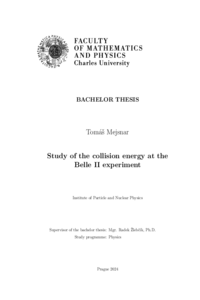Studium energie srážek v experimentu Belle II
Study of the collision energy at the Belle II experiment
bachelor thesis (DEFENDED)

View/
Permanent link
http://hdl.handle.net/20.500.11956/193611Identifiers
Study Information System: 261131
Collections
- Kvalifikační práce [11363]
Author
Advisor
Referee
Rybář, Martin
Faculty / Institute
Faculty of Mathematics and Physics
Discipline
Physics
Department
Institute of Particle and Nuclear Physics
Date of defense
10. 9. 2024
Publisher
Univerzita Karlova, Matematicko-fyzikální fakultaLanguage
Czech
Grade
Excellent
Keywords (Czech)
Belle II|kalibrace|Těžišťová energie srážekKeywords (English)
Belle II|calibration|Center-of-mass collision energyTato bakalářská práce se zabývá měřením rozptylu rozdělení těžišťové energie σECMS v experimentu Belle II. Byla vyvinuta nová metoda využívající rapiditu mionů z interakcí e+ e− → µ+ µ− . Tato metoda zahrnuje konvoluční techniky k dekompozici výstupu detektoru na komponenty rozlišení detektoru, fyzikální interakce a rozdělení energie svazku. Validace pomocí Monte Carlo simulací a aplikace na reálná data ukázala σECMS o hodnotě 5,28(1) MeV, což je v souladu s jinými měřeními. Tento přístup nabízí vyšší přesnost a spolehlivost oproti tradičním metodám, což zlepšuje přesnost měření hmotnosti částic. Výsledky podporují přesnější stanovení základních parametrů a posouvají naše chápání Standardního modelu. 1
This thesis addresses the measurement of centre-of-mass energy spread σECMS in the Belle II experiment. A novel method using the rapidity of muons from e+ e− → µ+ µ− interactions was developed. The method involves convolution techniques to deconstruct detector output into detector resolution, physical in- teraction, and beam energy spread components. Validation through Monte Carlo simulations and application to real data showed σECMS of 5.28(1) MeV, closely aligning with other measurements. This approach offers improved precision and reliability over traditional methods, enhancing the accuracy of particle mass mea- surements. The results support more precise determinations of fundamental pa- rameters, advancing our understanding of the Standard Model. 1
